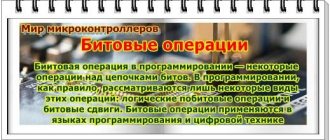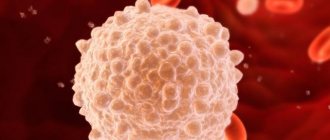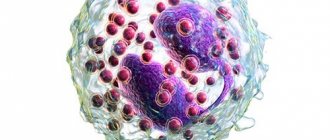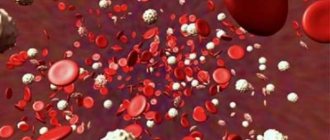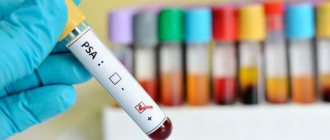From the article you will learn what a leukocyte blood formula is and a breakdown of test indicators in adults and children. What deviations mean and how to prepare for analysis.
Thanks to blood tests, the doctor can learn a lot of useful and important information about the health status of the patient being examined. The study of an indicator called the leukocyte formula is carried out in order to determine the type of disease, the nature of its course, the development of complications and the establishment of preliminary prognoses of the disease.
What is the leukocyte formula?
The leukocyte formula is an important indicator of the numerical ratio of all types of leukocytes, calculated as a percentage based on examination of a stained smear. The leukoformula is part of the common CBC analysis. It is determined in peripheral blood samples in several ways:
- Microscopy of blood from a finger - counting is done manually using microscopic examination.
- Studying blood from a vein - counting using automated methods.
Leukocytes, due to differences in cell size, have a specific location in the material under study: neutrophils, basophils and eosinophils are located at the edges, and lymphocytes with monocytes are in the central part of the smear.
Types of leukocytes in a leukogram
- Eosinophils are detected in allergies, parasitic infestations, infectious and autoimmune diseases, as well as in cancer.
- Neutrophils help fight acute infections by destroying the cell membranes of pathogenic microorganisms and their further phagocytosis (capture and destruction of foreign cells). They are divided into:
- Myelocytes (nascent) and metamyelocytes (young) cells - these should not be present in normal samples. They appear only in cases of severe infectious pathologies or blood diseases, accompanied by inhibition of the hematopoietic function of the bone marrow.
- Band neutrophils (young) - their number begins to increase during bacterial infections, when segmented neutrophils cannot cope with their task.
- Segmented cells (mature) are quantitatively superior to others. Needed for normal functioning of the immune system.
- Lymphocytes are a kind of cleaners: they find, identify and destroy antigens, and also promote additional production of antibodies by the body to ensure immune memory (remembering and quickly recognizing foreign agents).
- Monocytes - their main task is to absorb and process dead cells, bacterial, viral, etc. agents, atypical cells, fragments of own phagocytes, etc.
- Basophils - the exact functionality of these cells has not been reliably studied. It is known that they regulate allergic reactions and blood clotting processes. They are activated when a focus of inflammation occurs.
Plasma cells (plasmocytes) are necessary for the production of antibodies. Normally, they are allowed in the analysis in children, but they should not be present in adults. Plasmocytes appear only during acute pathology.
Neutrophil shifts in the formula
Neutrophils help the body resist infections. Normally, blood should include two types of them - band and segmented.
Band
These are immature young neutrophils. Ideally, they should not exist, like other immature cells. The amount is approximately the same in men and women, but may increase during pregnancy.
This shift is indicated if the number of band neutrophils exceeds 5%.
Segmented
These are mature blood cells whose main function is to protect the immune system. The normal number of neutrophils in the blood is 45–70% of all leukocytes. Any shift is a sign of illness.
All types of neutrophil shifts indicate possible diseases:
- infectious caused by viruses, bacteria, protozoa and rickettsia: influenza, measles, chickenpox, hepatitis, rubella, brucellosis, malaria, typhoid fever, typhus, paratyphoid fever;
- blood diseases (hypoplastic, aplastic, megaloblastic, iron deficiency anemia, hypersplenism);
- oncological diseases;
- congenital and drug-induced neutropenia - a decrease in the number of neutrophils;
- ischemic necrosis of myocardial or kidney tissue;
- diabetes;
- uremia;
- inflammatory processes;
- thyrotoxicosis;
- allergic reactions;
- condition after surgery or chemotherapy;
- physical or psychological stress;
- poisoning with lead, mercury and other toxic substances.
What does the leukocyte formula indicate?
This analysis is informative in diagnosing:
- Viral and bacterial infections (allows for differential diagnosis).
- Parasitic infestations.
- Diseases of allergic origin.
- Malignant neoplasms and leukemia (as an additional method of primary diagnosis).
- State of the patient's immune system.
Decoding the leukocyte blood formula in adults
When assessing a blood test for the leukocyte formula in an adult patient, specialists check certain indicators and their compliance with normal values.
The norm for deciphering the leukoformula in an adult is presented in the table:
| Index | Normal value | |
| % | X 109/l | |
| Band neutrophils | 1-6 | 0,04-0,3 |
| Segmented neutrophils | 45-72 | 2,0-5,5 |
| Eosinophils | 0,5-5 | 0,02-0,3 |
| Basophils | 0-1 | 0-0,065 |
| Monocytes | 3-11 | 0,09-0,6 |
| Lymphocytes | 19-37 | 1,2-3,0 |
Any recorded deviation from normal values is a reason for a more thorough examination. All results obtained are evaluated together with medical history, clinical symptoms, patient complaints and the results of other tests.
Decoding the leukocyte blood formula in children
There are constant changes in a child’s tests, depending on the growth and development of the body, so the normal blood count in children will depend on age. Immediately after birth, neutrophils predominate in the baby’s tests (approximately 65-70% of the total number of cells). Lymphocytes account for 25-30%.
During the first five days, the level of lymphocytes increases and neutrophils decrease. On day 5, the first physiological crossover is observed - the level of lymphocytes reaches 50-60%, and neutrophils - from 35 to 47%.
Closer to one month of age, the child’s body produces more lymphocytes than neutrophils, creating a strong immune system to resist bacteria. In the entire leukocyte mass, lymphocytes themselves account for up to 65%, and neutrophils account for about 15-20%. This blood leukoformula in children provides a 1-year-old baby with a strong immune system, which is important for the period of active development.
After the first year, when the immune system is already fully formed, the amount of lymphocyte mass gradually decreases.
By the age of four, another crossover occurs, during which lymphocytes are again compared with neutrophils, forming a barrier to the penetration of pathogenic microorganisms. After it, the number of neutrophils continues to increase, and lymphocytes decrease.
Closer to the sixth year, deciphering the leukocyte formula of a child’s blood increasingly resembles the analysis of an adult, in which the bulk falls on neutrophils and lymphocytes.
How is the analysis carried out?
To count the total number of all types of blood cells, OAC is prescribed. The result of the study is presented in the form of a table, which indicates the values of lymphocytes, monocytes, neutrophils, basophils and eosinophils.
For the study, blood is taken from the ring finger or vein of the elbow. Leukocyte counting is carried out by a laboratory assistant using a microscope. In addition to this method, a special automatic device is used - an analyzer. If a general blood test with a leukocyte formula shows deviations from the norm, an additional blood smear examination is prescribed, during which the cellular morphology is described.
Differentiation of blood cells is carried out by 2 methods:
- According to Schilling - the number of leukocytes is counted in 4 parts of the smear.
- According to Filipchenko, a blood smear is conditionally divided into 3 segments, and the bodies in each of them are counted.
Types of blood cells studied:
- Neutrophils - have the ability to identify pathogenic, disease-causing cells and have an inhibitory effect on them until they are completely destroyed.
- Basophils - arise as a result of allergic reactions, intoxication with poisons and toxins, prevent the spread of toxic substances throughout the body.
- Eosinophils - destroy parasites, protect the body from parasitic pathogens, increasing the body's resistance.
- Monocytes - have a similar effect to eosinophils, but with a more pronounced phagocytic function: they destroy parasitic microorganisms and cleanse the blood.
- Lymphocytes have memory, which helps them recognize antigens and remember them. They influence the immune system, increasing its resistance to cancer cells and viral pathogens.
Important information: What does low platelet count mean in a child?
Leukocytes are indicators of human health. Their determination in a general blood test helps to accurately establish a diagnosis and identify pathologies that can occur for a long time without a pronounced symptomatic picture. Counting the leukocyte formula gives a conclusion about the state of the immune system.
What is a leukocyte formula shift?
In the standard leukocyte formula, young neutrophils are indicated from left to right, followed by more mature cells. The first step is to take into account the relationship between these two categories. The shift is classified into 3 types: left, with rejuvenation and right.
Shift in leukocyte formula
What is a shift in the leukocyte formula to the left?
A condition indicating the predominance of young cells in the bloodstream over mature ones, but due to their weak biological activity, they are not capable of normal maintenance of immunity. The reason for this phenomenon is often:
- Blood loss.
- Diseases accompanied by inhibition of the hematopoietic function of the bone marrow.
- Aseptic inflammatory processes.
- Malignant neoplasms.
- Infection with a purulent nature.
- Intoxication of the body.
When a shift in the leukocyte formula to the left with pronounced rejuvenation is detected, the result may indicate blood diseases (leukemia).
Read further: ESR in oncology - the norm and the relationship with cancer
What is a shift in the leukocyte formula to the right?
A condition that occurs when a growth of mature white blood cells is detected, with a predominance over all other types of cells. Such decoding is possible in the following conditions:
- Liver disorder
- Kidney dysfunction.
- Exposure to ionizing radiation.
- Regular blood transfusions.
After the analysis, the laboratory technician calculates the so-called shift index, which reflects the level of the total number of new leukocytes to more mature ones.
The leukocyte blood count allows for differential diagnosis between infections of viral and bacterial origin, as well as to suspect the presence of parasitic infestations and the presence of malignant neoplasms.
Decoding the analysis in adults
A general clinical blood test includes a list of indicators that will tell you a lot about a person’s state of health and help make the correct diagnosis.
The laboratory technician counts the number of platelets, red blood cells and white blood cells, determines the amount of hemoglobin and hematocrit level, and calculates the erythrocyte sedimentation rate (ESR). It does not take much time to calculate the leukocyte formula; usually the decoding in adults and children is known a few hours after donating blood. This is often done not manually, as several decades ago, but with the help of automated modern devices - blood analyzers. In our country, 5 diff hematology analyzers are used for this.
A shift to the right indicates that there are more mature cells than young ones, that is, the process of producing new neutrophils is slowed down for some reason. To assess the degree of shift, the ratio of young cells to segmented cells is calculated. If segmented neutrophils are elevated, this is a sign of either a recent blood transfusion or the development of the following pathologies:
- deficiency of vital vitamin B12;
- radiation sickness;
- some types of anemia.
A shift to the left may indicate a wider range of possible pathological abnormalities associated with inflammatory processes. It accompanies various infectious diseases, intoxication of the body, and other inflammations of internal organs. Therefore, when a shift to the left is detected, additional examination is always required.
Deviations from the noma in adults
Lymphocytosis, manifested by an increase in the concentration of lymphocytes in the bloodstream, can indicate the development of one of the following pathologies:
- Chicken pox.
- Syphilis.
- Rubella.
- Leukemia.
- Lymphoma.
- Tuberculosis.
- Measles.
Low lymphocyte counts may occur due to:
- Immunosuppressive conditions.
- Autoimmune diseases.
- Kidney dysfunction.
- Deficiency of nutrients and microelements.
- Radiation therapy.
- Treatment with corticosteroids.
An increase in the number of neutrophils is an important indicator of the following diseases:
- Acute hemorrhage.
- Intoxication.
- Development of diseases of bacterial etiology.
- Myocardial infarction.
- Vasculitis.
- Malignant neoplasms.
- Autoimmune pathologies.
If the analysis shows a low concentration of neutrophils, doctors may suspect the following pathologies:
- Immunosuppressive conditions.
- Effect of ionizing radiation.
- Progressive infectious disease.
An increase in monocytes indicates the following conditions:
- Infections that occur due to the influence of bacteria.
- Progression of rheumatoid arthritis.
- Infectious mononucleosis.
- Parasitic infestations.
- Hemoblastoses.
A low concentration of monocytes in the lymphocyte formula helps to suspect pulmonary tuberculosis. If a high level of basophils is detected, one may think about the presence of chronic myeloid leukemia or erythremia. Deciphering the leukocyte formula in adults may show an increase in eosinophils, which is often detected during:
- Allergies.
- Scarlet fever.
- Parasite infestations.
- Skin pathologies.
- Eosinophilic leukemia.
A decrease in eosinophils in an adult can be triggered by progressive typhoid fever or adrenal hyperactivity. Deciphering the leukogram is performed with an assessment of nuclear shifts, where special attention is paid to the ratio of mature and immature neutrophils.
At the moment, the leukocyte formula is considered one of the most important indicators in diagnosis. Carrying out a CBC with an assessment of the leukogram makes it possible to discuss the presence of acute pathological conditions, the effectiveness of the prescribed therapeutic course, as well as possible prognoses for the future.
Deviations
Deciphering the leukocyte formula in the blood has important diagnostic value. To determine the development of any diseases, it is not enough to count the number; one should also take into account such parameters as the excess of mature cells over young ones, and vice versa, the age of blood cells, so only a doctor can decipher the results, taking into account all the characteristics. In case of controversial results, daily dynamics are measured.
Important information: What is erythrocyte microcytosis in a general blood test in women (children)
The white blood cell count may be higher or lower than normal.
Promotion
A general blood test with counting the number of leukocytes determines their main types, and it often happens that some of them are within normal limits, while others are elevated.
Neutrophils increase for the following reasons:
- infectious diseases;
- development of a pathogenic fungus in the body, including with a disease such as candidiasis;
- rheumatism;
- diabetes mellitus, including at the initial stage, when the level of glucose in the blood exceeds the norm;
- oncological neoplasms, regardless of their location in the body;
- emotional and physical fatigue;
- pain of various etiologies;
- increased body temperature or its extreme decrease.
Reasons for increased lymphocytes:
- infectious diseases;
- blood diseases;
- intoxication of the body with lead or mercury;
- long-term use of certain medications.
Monocytes increase due to infectious diseases during the period of recovery of the body. If this indicator is always elevated in the blood, this may be a sign of autoimmune diseases or the presence of cancer.
An increase in eosinophils is caused by:
- allergic reactions;
- use of antibacterial drugs;
- taking medications against seizures and drugs for the treatment of tuberculosis;
- skin diseases.
Basophils deviate from the norm upward in acute influenza, chicken pox, active stage of tuberculosis, colitis, duodenal or gastric ulcer.
The general leukocyte formula in a blood test and its elevated values must be deciphered, taking into account the condition of the subject. An increase in leukocyte cells does not always indicate the development of pathological processes, but may be physiological in nature. Thus, an increase is observed in the gestational period, after vaccination and excessive physical activity, during menstruation.
Important information: Normal ESR levels in the blood of men by age (table)
Demotion
Neutrophils decrease due to:
- allergic reaction;
- long-term use of antibacterial drugs;
- typhoid fever;
- tuberculosis;
- anemia;
- anaphylactic shock.
The decrease in lymphocytes is due to:
- immunodeficiency states;
- acute inflammatory processes;
- systemic lupus erythematosus;
- renal failure.
Lymphocytes will be low for some time after a person has been exposed to x-ray radiation.
Monocytes decrease below normal due to aplastic anemia, the development of diseases of the oncohematological type, and with pyogenic (purulent) infections.
Monocytes can also decrease as a result of a state of shock or prolonged use of certain medications.
The decrease in eosinophils is influenced by:
- infections with purulent foci;
- acute inflammatory processes;
- intoxication of the body with heavy metals and their compounds.
Basophils can decrease due to physiological reasons: pregnancy, ovulation, stress.
Possible deviations from the norm in children
Any changes in the leukogram, be it a shift in the leukocyte formula to the left or right, as well as an increase or decrease in the leukocyte index of intoxication in a child, always indicate the onset or progression of various pathologies.
A high concentration of lymphocytes (lymphocytosis) is diagnosed when the body is affected by an infection of any etiology:
- Whooping cough.
- Flu.
- Rubella.
- Measles.
- Tuberculosis, etc.
In addition to the above, an increase in the concentration of cells can be caused by diseases such as asthma, autoimmune pathologies, and allergic reactions. A significant deficiency of leukocytes at this age (lymphocytopenia) indicates pathological damage to the bone marrow.
A large number of neutrophils (neutrophilia) or a neutrophil shift to the left in the first days of life is a physiological condition. Subsequently, a crossover of the leukocyte formula occurs.
Pathological neutrophilia may indicate inflammation of the umbilical wound (omphalitis), enterocolitis, streptococcal infection, etc.
An increase in the number of monocytes is characterized as a condition (monocytosis) that occurs due to fungal or viral infection. In this situation, the symptoms need to be judged by some visual signs:
- Lymphadenopathy.
- Inflammation in the nasopharynx and larynx.
- Hepatomegaly and pain in the right hypochondrium.
In addition, a shift in the leukocyte count to the right or left is often associated with a deficiency of monocytes (monocytopenia). A similar condition can develop with a lack of B vitamins and folic acid. This problem is often accompanied by iron deficiency or B12 and folate deficiency anemia.
An increase in the number of basophils (basophilia) is a fairly rare condition. The cause may be the patient’s tuberculosis, lymph node damage, or myeloid leukemia.
Eosinophils can also cause a shift in the leukocyte formula to the left or right. Eosinophilia may be due to allergies or the presence of parasitic worms.
Normal indicators
The norms for the content of different bodies belonging to the group of leukocytes vary depending on the age of the children. The number of some cells increases, while others decrease, even with normal development. At certain moments, the number of different leukocytes equalizes. This is called formula crossover and is not considered a pathology. Crossover most often occurs during the first year of a child's life.
The reason for the change in the number of white blood cells is the formation of the immune system and the development of resistance to pathogenic microflora. A sharp jump in the content of leukocytes occurs 1 week after birth, then their number increases gradually. At 4 and 6 years of age, a new sharp growth of protective cells in the blood occurs. During puberty, fluctuations in the ratio of different types of leukocytes are caused by hormonal changes.
Important information: Where are red blood cells formed in the human body?
Eosinophils
This type of white blood cell is practically not found in the blood, and the norm in childhood changes slightly. The role of eosinophils is to fight parasites and prevent allergic reactions. The norm in newborns is 1-4%, from 10 days of age to 1 year it can increase to 5%. For one-year-old children, the content is again set at 1-4%.
Neutrophils
Among neutrophils, young, medium and mature cells are distinguished. The normal content of mature neutrophils is greater than average ones, and young ones should be absent from the blood if there are no pathologies. Varieties of neutrophils are also segmented (designated by the letter C) and band (R). The names reflect the shape of their nuclei, which are found under a microscope.
The content of segmented cells is constantly changing:
- 50-70% - in newborns;
- 35-55% - in 5-30 days;
- 17-30% - 1-12 months;
- 20-35% - up to 5 years;
- 35-55% - 5-9 years;
- 40-60% - from 10 years and older.
Bands make up 4-12% immediately after birth, and then their number drops. From 5 days of age, the norm for this variety is 1-5%. In children over 5 years of age, the amount should not exceed 4%.
Basophils
Responsible for the body’s immune response and adequate response in the event of the penetration of infectious agents. Normally, their content can be 0%, but most often they detect about 1% of basophils in the blood. The number of cells does not change at different periods of life, and their appearance in large numbers occurs during diseases.
Monocytes
The task of monocytes is to remove dying cells from various tissues and protect against inflammatory reactions of the body. The functions of these defenders also include the fight against microbes that have entered the blood. The average rate should not exceed 15%. For newborns it is 4-10%, and from 5 days it increases to 14%. By 1 year, the rate decreases to 5-12%, and continues to fall as the child grows. For teenagers it is only 7% and subsequently remains at approximately the same level.
Lymphocytes
Lymphocytes are divided into many subtypes, but their main function is to fight viruses. The normal content of these cells in the blood of a newborn is about 30%, then it increases by about 2 times and fluctuates around 50-60% until the age of 9. By the age of 10, it decreases to 45% and remains at this level into adulthood.
Important information: What is erythrocyte hypochromia in a general blood test
Indications for analysis
Collection of biomaterial for subsequent assessment of the leukogram is advisable in one of the following cases:
- Passing a medical examination.
- Pregnancy planning.
- Preparing for surgery.
- Diagnosis of any pathology (leukocyte formula refers to one of the main types of walking OAC).
- Exacerbation of chronic pathology.
- Acute abdominal pain, increased sweating at night, weight loss, shortness of breath, diarrhea, enlarged lymph nodes.
Clinical indications for prescribing OAC with leukogram:
- Hyperthermia.
- Feverish condition.
- Pain in the joints.
- Body aches, general malaise.
- Headache.
- The need for differential diagnosis between viral and bacterial infections.
- Enlarged lymph nodes.
- Increased bleeding.
- Pustular rash on the body.
- Taking immunosuppressive drugs.
- Carrying out chemotherapy or radiation therapy.
- Night sweats.
- Routine examination during hospitalization.
- Routine examination of pregnant women.
Preparing for analysis
To obtain the most reliable analysis results, the patient must prepare for the blood sampling procedure:
- Blood is taken in the morning, strictly on an empty stomach (you must wait more than 10 hours from the moment of eating to the analysis). Some time before the procedure, you can drink a glass of plain water.
- You need to exclude fatty, smoked, spicy foods and tonic drinks (coffee, strong tea, energy drinks), as well as any alcohol from your daily menu 3-4 days before the procedure.
- 1-2 hours before the scheduled time of blood sampling, you should not smoke (cigarettes, hookahs), you should not lift weights, or be nervous.
Immediately after collection, the test tube with the biomaterial is sent to the laboratory for testing. The laboratory assistant, using a microscope, determines the ratio of all visible leukocytes and calculates the leukogram. In addition, an automatic analyzer can be used for more accurate and faster results.
Read further: How long does alcohol last in a person’s blood (table)?
Analysis technique
Calculations of the leukocyte formula are carried out by qualified health workers using the method of studying smears under a microscope.
In addition, a hematology automatic analyzer is often used. If certain deviations are detected, an additional microscopic assessment of the smear is carried out, with a description of the clear morphology of visible cells and clarification of the leukogram.
Automatic devices make it possible to obtain better results: with technology, it is possible to examine more than 2000 cells, and under a microscope only 200. During a blood test on an analyzer, the result will be more informative.
Automatic counting also has a number of disadvantages, because it is not able to distinguish neutrophils into segmented and band types.
What is a leukogram in the UAC?
We are talking about the indicators of the five main types of leukocytes, expressed as a percentage. Leukocytes (white cells) are able to protect human health from harmful microorganisms and fight infections, toxic substances, stress and other negative factors.
To calculate this formula, laboratory technicians process the blood smear in various ways: drying, staining and counting under a microscope. To obtain a result, there must be 100-200 blood cells on the smear. First, the total number of leukocytes is counted, then the cells of each type are counted separately and the average value is displayed. To determine the morphological structure of leukocytes and the structure of their plasma, the Romanovsky-Giemsa staining method is used.
